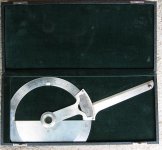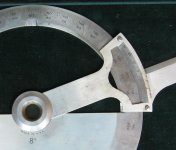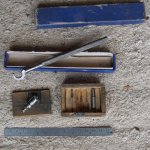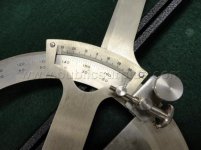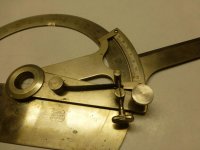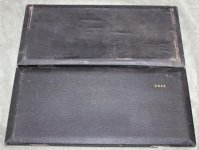peter
Titanium
- Joined
- Mar 20, 2001
- Location
- New England
Ive been at it again. I found a few tools at an engine show this weekend and like to ask some help to identify a protractor, maker and purpose. Only markings are
8"
Made in USA
It has a cross hair in glass viewer with a vernier scale, ranging over a 200 degree arc. Appears very well made and nicely finished in a case. I assumed this was a drafting tool? But why so accurate? It was sold at a table with other machinists tools, could it be for layout? Pattern making?
Second: I got a Starrett Trammel, which is somehting I have wanted for a while.
Third: there is a odd (to me) little inside bore gauge from Brown and Sharpe. I would also like to ask you guys, if this B&S is a considered a rare tool or just one more of many things I have yet to see.
8"
Made in USA
It has a cross hair in glass viewer with a vernier scale, ranging over a 200 degree arc. Appears very well made and nicely finished in a case. I assumed this was a drafting tool? But why so accurate? It was sold at a table with other machinists tools, could it be for layout? Pattern making?
Second: I got a Starrett Trammel, which is somehting I have wanted for a while.
Third: there is a odd (to me) little inside bore gauge from Brown and Sharpe. I would also like to ask you guys, if this B&S is a considered a rare tool or just one more of many things I have yet to see.


